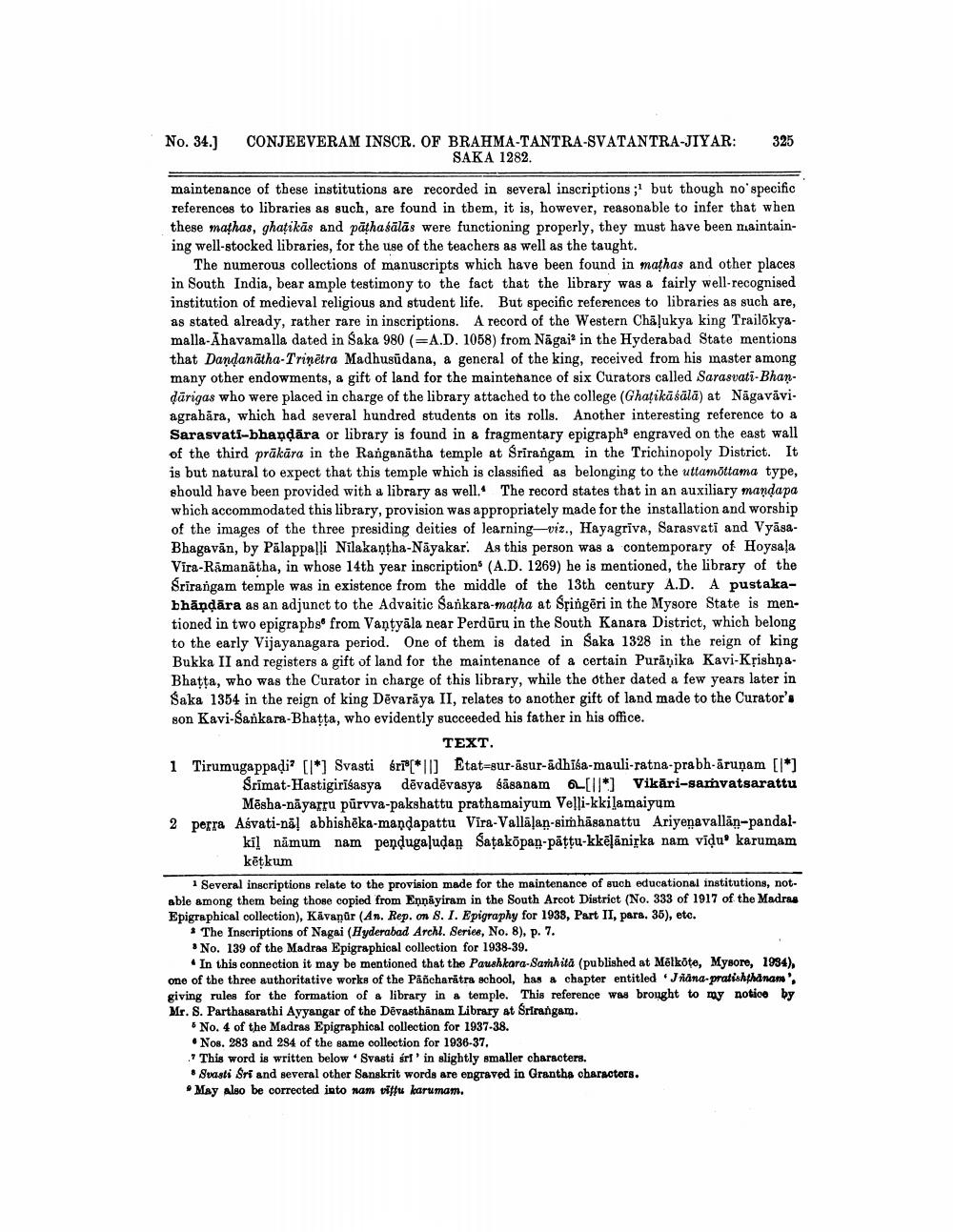________________
No. 34.]
CONJEEVERAM INSCR. OF BRAHMA-TANTRA-SVATANTRA-JIYAR:
SAKA 1282.
325
maintenance of these institutions are recorded in several inscriptions ;' but though no specific
references to libraries as such, are found in them, it is, however, reasonable to infer that when these mathas, ghatikās and pathaśālās were functioning properly, they must have been maintaining well-stocked libraries, for the use of the teachers as well as the taught.
The numerous collections of manuscripts which have been found in mathas and other places in South India, bear ample testimony to the fact that the library was a fairly well-recognised institution of medieval religious and student life. But specific references to libraries as such are, as stated already, rather rare in inscriptions. A record of the Western Chāļukya king Trailõkyamalla-Ahavamalla dated in Saka 980 (=A.D. 1058) from Nāgaid in the Hyderabad State mentions that Dandanātha-Trinētra Madhusūdana, a general of the king, received from his master among many other endowments, a gift of land for the maintenance of six Curators called Sarasvati-Bhandärigas who were placed in charge of the library attached to the college (Ghatikāśālā) at Nāgavāvi. agrahāra, which had several hundred students on its rolls. Another interesting reference to a Sarasvati-bhandara or library is found in a fragmentary epigraphe engraved on the east wall of the third prākāra in the Ranganātha temple at Srirangam in the Trichinopoly District. It is but natural to expect that this temple which is classified as belonging to the uttamóttama type, should have been provided with a library as well. The record states that in an auxiliary mandapa which accommodated this library, provision was appropriately made for the installation and worship of the images of the three presiding deities of learning--viz., Hayagriva, Sarasvati and VyāsaBhagavān, by Pälappalli Nilakantha-Nāyakar. As this person was a contemporary of Hoysala Vira-Rāmanātha, in whose 14th year inscription' (A.D. 1269) he is mentioned, the library of the Srirangam temple was in existence from the middle of the 13th century A.D. A pustakabhāņdāra as an adjunct to the Advaitic Sarkara-matha at Spingēri in the Mysore State is mentioned in two epigraphs from Vantyāla near Perdūru in the South Kanara District, which belong to the early Vijayanagara period. One of them is dated in Saka 1328 in the reign of king Bukka II and registers a gift of land for the maintenance of a certain Purāņika Kavi-KrishnaBhatta, who was the Curator in charge of this library, while the other dated a few years later in Saka 1354 in the reign of king Dēvarāya II, relates to another gift of land made to the Curator's son Kavi-Sankara-Bhatta, who evidently succeeded his father in his office.
TEXT. 1 Tirumugappaļi? [I*] Svasti sri@[* Il] Etat=sur-āsur-ādhīsa-mauli-ratna-prabh-āruņam [l*]
Srimat-Hastigirīgasya dēvadēvasya Sasanam [U*) Vikāri-samvatsarattu
Mēsha-nāyafru pūrvva-pakshattu prathamaiyum Velli-kkilamaiyum 2 perra Asvati-nā! abhishēka-mandapattu Vira-Vallāļan-simhāsanattu Ariyenavallān-pandal
kil nãmum nam pendugaludan Satakopan-pattu-kkēlāniska nam vidu karumam
kētkum 1 Several inscriptions relate to the provision made for the maintenance of such educational institutions, notable among them being those copied from Ennayiram in the South Aroot District (No. 333 of 1917 of the Madras Epigraphical collection), Kavanur (An. Rep. on 8. I. Epigraphy for 1938, Part II, para, 36), eto.
* The Inscriptions of Nagai (Hyderabad Archi. Series, No. 8), p. 7.
No. 139 of the Madras Epigraphical collection for 1938-39.
• In this connection it may be mentioned that the Paushkara-Samhita (published at Melkote, Mysore, 1994), one of the three authoritative works of the Pancharitra school, has a chapter entitled Jnana pratishthanan, giving rules for the formation of a library in a temple. This reference was brought to my notice by Mr. S. Parthasarathi Ayyangar of the Devasthanam Library at Srirangam.
* No. 4 of the Madras Epigraphical collection for 1937-38. .Nos. 283 and 284 of the same collection for 1936-37. ,7 This word is written below. Svasti śrl' in slightly smaller characters.
• Svasti Sri and several other Sanskrit words are engraved in Grantha characters. . May also be corrected into nam vittu karumam.




